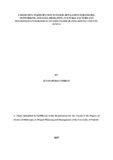| dc.description.abstract | The purpose of this study was to investigate community participation in flood mitigation strategies, networking and collaboration, cultural factors and household livelihood in Nyando flood Plains, Kisumu County. Every year, the government, the Non Governmental Organizations and other relevant bodies have been involved in mitigating floods using different strategies. The households seem not to benefit from these strategies despite their presence. They keep on asking for help from the government whenever floods occur. Therefore the study investigated the following objectives: to establish the extent to which community participation in management of water shed as a flood mitigation strategy influence household livelihood, to determine how community participation in information sharing as a flood mitigation strategy influence household livelihood, to assess the level at which community participation in training and sensitization as flood mitigation strategies influence household livelihood, to determine how combined community participation in flood mitigation strategies influence household livelihood in Nyando plains, Kisumu County, to examine the influence of networking and collaboration on the relationship between community participation in flood mitigation strategies and household livelihood, to establish the influence of cultural factors on the relationship between community participation in flood mitigation strategies and household livelihood. This study adopted pragmatic research paradigm where both quantitative and qualitative designs was incorporated, descriptive survey design as a method of inquiry. The target population was 11050, where 385 sample size was appropriate according to Krejcie and Morgan table 1970. The study used structured questionnaire for the 370 household heads and an interview schedule where 4 Village elders and 4 chiefs, 1 officer in charge of the local sub county authority, 5 managers of NGOs and 1 Sub-County Disaster Management Officer in Nyando sub-county. Descriptive and inferential statistics was used for analysis. Mean, standard deviation, correlation, simple linear regression and multiple linear regression analysis was used. The qualitative data was processed using theme analysis and focused on the accuracy and reliability in relation to the study’s predesigned objectives Reliability analysis returned a Cronbach’s alpha value of 0.925. The study results revealed that community participation in management of the watershed as a flood mitigation strategy statistically influence household livelihood with a strong positive correlation of r = 0.653, hence the model explained up to 42.7% of the variance in household livelihood as R2 change was 0.427; community participation in information sharing as a flood mitigation strategy had a strong positive correlation of r =0.679 which was statistically significant, hence the model explained up to 46.1% of the variance in household livelihood as R2 change was 0.461 ; Community participation in training and sensitization as a flood mitigation strategy had a positive correlation of 0.582, hence the model explained up to 33.8% of the variance in household livelihood as R2 change was 0.338 ; for combined community participation in flood mitigation strategies the study noted a contribution of up to 58.9% of the variance in household livelihood with R2 change of 0.589. Influence of networking and collaboration on the relationship between community participation in training and sensitization as a flood mitigation strategy and household livelihood, with introduction of interaction term, predicts up to 40.7% with R2 change of 0.023 which was statistically significant. Influence of cultural factors on the relationship between community participation in management of the watershed as a flood mitigation strategy and household livelihood, with the interaction term predicted up to 44.0% of the variance and R2 of 0.010 with p 0.011 which was statistically significant. The study results were expected to help the counties in Kenya in providing information on community participation in food mitigation strategies among the households and in understanding the influence of networking and collaboration and cultural factors as moderating variables that influence either positively or negatively towards achieving Sustainable Development Goals (SDSs), the 2030 Agenda. Based on the findings, the study recommended that the Ministry of Water and Irrigation ensures participation of households in Nyando flood plains in management of the watershed, information sharing and training and sensitization, as these flood mitigation strategies influences positively the household livelihood. The government, NGOs and International communities to join hands in networking and collaboration with the community in mitigating floods through management of the watershed, information sharing and training and sensitization as flood mitigation strategies to enhance their household livelihood. The study recommended that other studies on influence of community participation in flood mitigation strategies be investigated in other counties in Kenya in order to compare. The study alsorecommended that community participation in flood mitigation strategies be incorporated as part of the policy to compel communities to participate in flood mitigation strategies, improving networking and collaboration in order to enhance their household livelihood. The study concluded that community participation in management of the water shed, information sharing and training and sensitization as flood mitigation strategies influence household livelihood. The study also recommended that a similar study be done to cover a wider area in the western region to establish the influence of community participation in flood mitigation strategies on household livelihood. | en_US |



